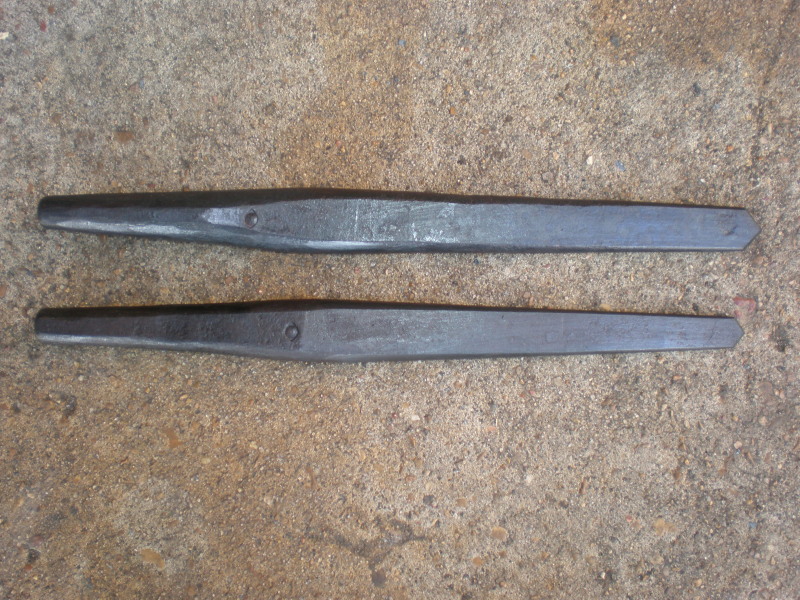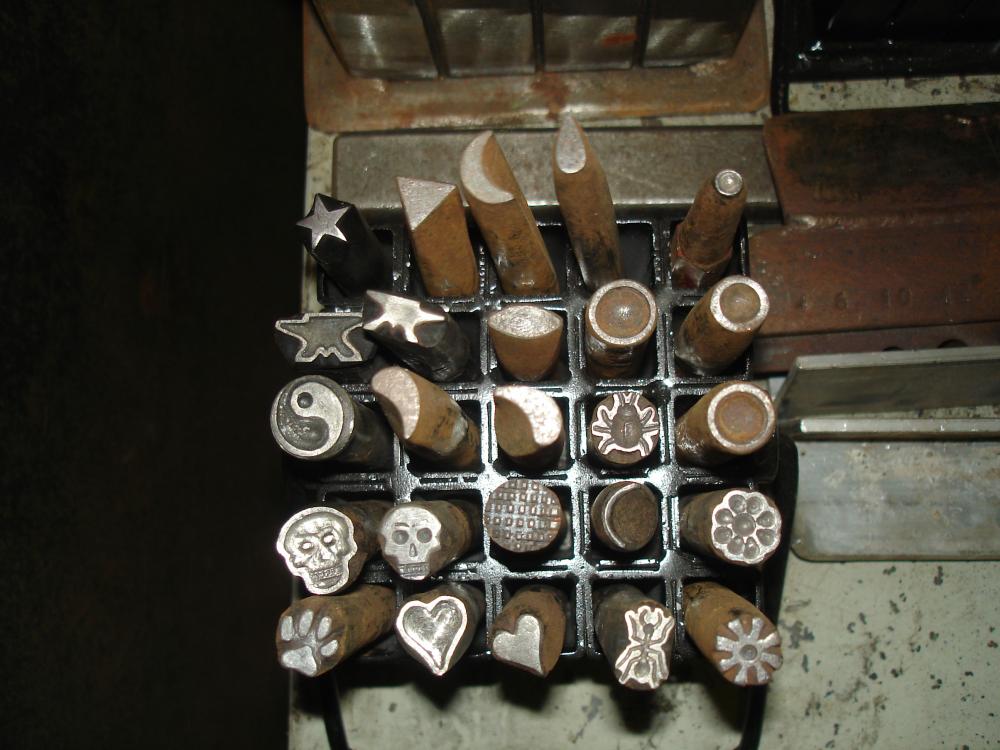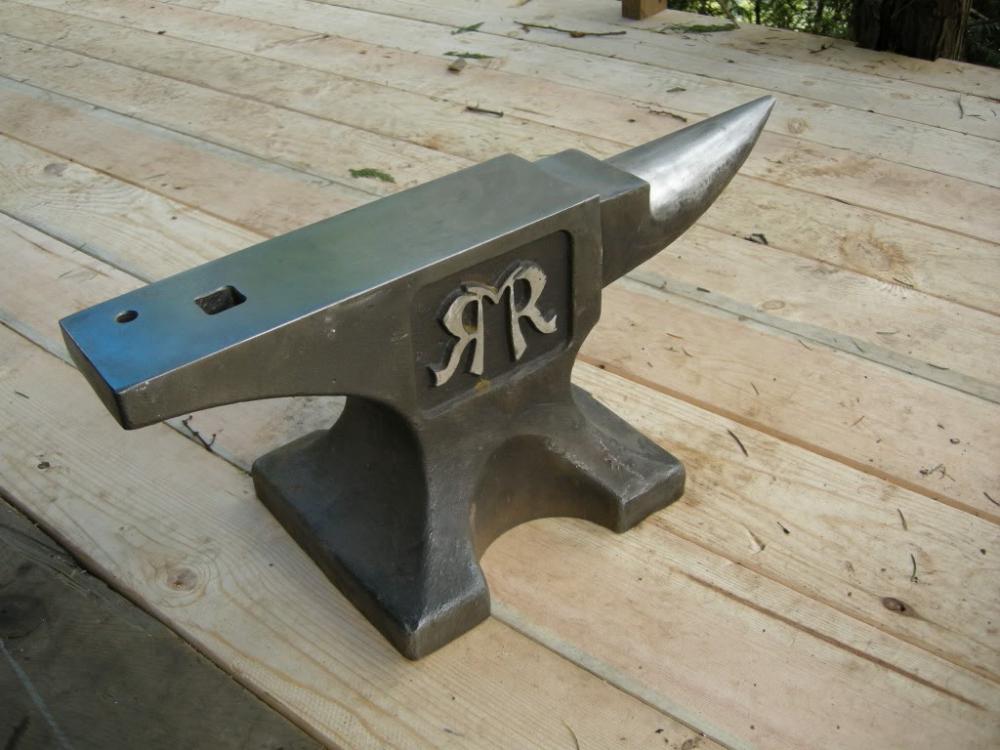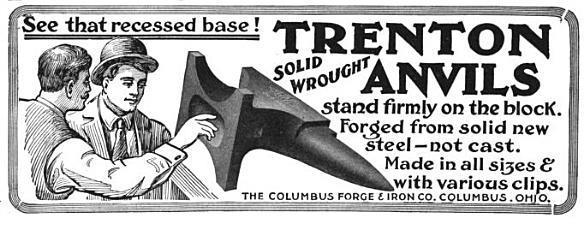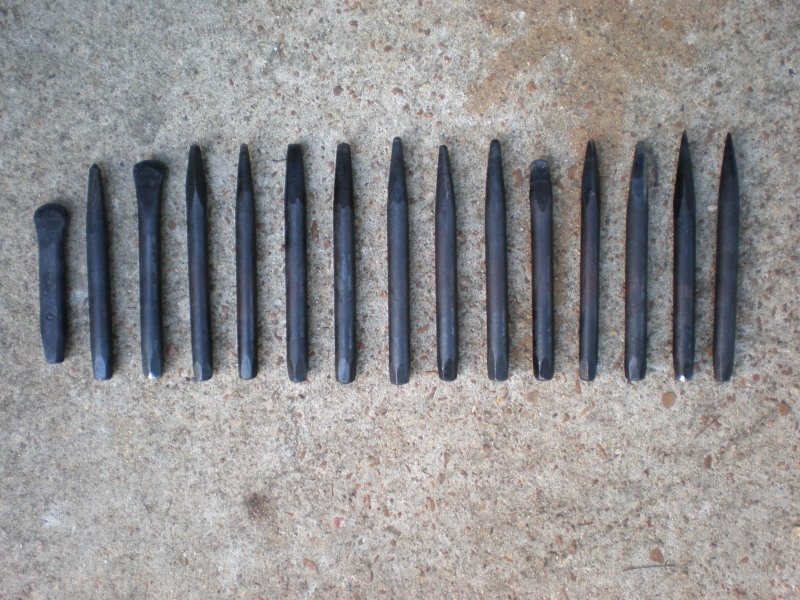-
Posts
2,335 -
Joined
-
Last visited
Content Type
Profiles
Forums
Articles
Gallery
Downloads
Events
Everything posted by John McPherson
-
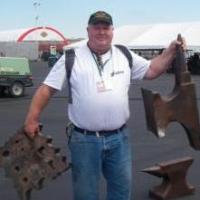
Where to get square/round stock
John McPherson replied to Pr3ssure's topic in Blacksmithing, General Discussion
Ray Clontz used one of the adjustable airbag/spring sets to make a hands-free leg vise. A foot pedal allowed you to open or close like a hydraulic press. Ya gotta make it beefy though, the prototype out of small C-channel warped. 100psi X volume of airbag = SMOOSH! -

DIY anvil stand
John McPherson replied to American Piddler's topic in Stands for Anvils, Swage Blocks, etc
Out of all of the many, many magnificent traits that I am proud of, I am proudest of my humility! -
Do an image search for "corrogated panel art projects", and let your bootstrap business empire begin!
-
There are those that strive for technical perfection, art for art's sake, etc. Slavish attention to historical accuracy, period methods and tooling, endless study and cataloging of examples. And go broke doing it, or just get frustrated because no one "recognizes their Genius" and quit. There are those that take one or two classes, buy $20K of tools, convert their garage, copy someone else's stuff from a website, set up at one show, and wonder why they are not making six figures already because no one wants to buy their lifeless imitations of art. And then there are the bozos that mutilate (way too heavy to be historically accurate) bar stock in a forge to give it that 'Old Timey' look, MIG weld (poorly), plasma cut, drill all the holes with a drill press, and huckster $10K of dubious historical accuracy items at weekend shows. Every month. For twenty years. MIG welded squirrel cookers, anyone? ("Got a hunnert of em, jest like Johnny Reb used on th' march.")
-
So, I went to the listing, and looked at all the photos. Pretty low resolution, but the pitting seems to be the same on the face as on the sides, which have no markings. May or may not have a steel face. Check it out in person with a small hammer or a ball bearing. See if a file skates or bites on the face, or if the face dents under the hammer. If it has good rebound and a hard face, it is a steal at that price. If not, it is an ill shaped boat anchor.
-
Ooh! Ooh! If you left the rivets a little loose as articulated joints, it would be pose-able! Add a couple more in the neck and tail, and it will be unique.
-
I did a Google image search for inspiration, and came back with quite a few hits from "metal lizard". I think that forging it all out of one piece of bar stock in a reasonable amount of time would be a struggle for anyone other than a fairly advanced smith. It would certainly be a growth opportunity for your skills, but there would be a lot of scrap-making and frustration along the way. Not burning off one foot in the forge while you work on the rest is the challenge. Do you feel that making some cuts in a pre-form would be cheating, rather than chiseling? How about forging the head, body and tail in one piece, and then welding on the legs from smaller stock? Hide the arc welds under the body. Easiest solution is to cut the body out of thin sheet metal, and hammer the body over a dishing stump. Lots of opportunity to add texture or cut patterns in the body.
-

Who manufactured my anvil?
John McPherson replied to Gerdus Kemp's topic in Anvils, Swage Blocks, and Mandrels
I will go one step further and say "Best Warranted" William Foster used that on the side, as did Norrisez and a few others. A 4 digit date under the words would make it a Foster. -

Any very tall smiths?
John McPherson replied to GandalftheGold's topic in Personal Protection Equipment
I have the opposite problem: I am a walking fire hydrant. 5'9", 330lbs.** I need a 58 chest, 46 -48 waist, and a 26 inseam. Web sites for odd sizes not carried in stores, and a list of local seamstress/alteration shops are your friend if you are on the ends of the bell curve. **On the plus side, all I need for a Halloween costume as Ben Grimm is a bucket of red clay and a sunlamp! -

Another mystery forging
John McPherson replied to canada goose's topic in Blacksmithing, General Discussion
yves, the fine folks that run the Jas. Townsend & Sons re-enactor's supply catalog have a youTube channel devoted to 17th-19th century cooking, and might be interested in some of your research. They also sell handmade items from craftsfolk of all trades, and might be an outlet for some of your wares. Crazy Crow trading post is another. (No financial ties except being a customer.) -
Andy Phillips of Oak Hill Iron has been doing a youTube video blog (vlog) every week for over a year now about the business of moving metal. He recently made the point that the amount of traditional forge welding done in a 'modern' shop is inversely proportional to the output. You can do anything you want as research or a hobby, but clients pay the bills in a business setting. Even making your own pattern welded steel, a mainstay of bladesmiths, slows production waaaayyy down, and makes the item's cost go up proportionally. And they are using welders on the parts that the client never sees: sealing canisters, tacking layers together in billets, attaching billets to rod handles instead of using tongs, etc. And using power hammers and presses, but not by rushlights and oil lamps. A museum demo is just that, a demonstration of how it used to be, hopefully as historically correct as you can make it. Business is something that runs by efficiency, or it is a very short run. If you are aiming for that elite 1% clientele to whom money is no object, you are passing up 99% of your potential client base.
-
More than just a wire feeder, there is an agitator in-line in the wire feed. The wire is pulsing in and out like a tattoo gun needle, which helps to flatten out the puddle. Expensive, yes, but you get TIG quality with MIG speed. About a 500% speed increase on average, YMMV.
-
From wikipedia: "Bourg-de-Péage is a commune in the Drôme department and in the Auvergne-Rhône-Alpes region in southeastern France. The inhabitants are called Péageois." So this is a piggy made by Peageois? I'd be Lyon if I said I was not amused!
-
Would that be the logo on the foot on the same side as the triangle C? Inquiring minds want to know!
- 7 replies
-
- anvil
- double horn
-
(and 1 more)
Tagged with:
-
Punches and chisels can be turned into..........punches and chisels! But with different ends suited for specific tasks. You already know that is a suitable steel to use, and don't need to waste time and energy on worthless mystery metal, only to end up with scrap. A coffee can full of decorative punches is a wonderful thing to have available, or to sell and trade. The skills learned in making them will push you further down the path to metal mastery. If you have suitable tongs or vise grips, short punches weigh less for traveling, can be used at the anvil, as well as with power hammers or treadle hammers. One long hand star drill might make a half dozen stubby punches. Or one good hammer eye drift. If you want cheap medium carbon stock for making into decent quality blades without spending time changing round into flat first, look for carpenters pry bars at flea markets. Heck get a half dozen identical ones on sale at HF and spend a weekend on mastering one common steel.
-

What did you do in the shop today?
John McPherson replied to Mark Ling's topic in Blacksmithing, General Discussion
Flint strikers and arrowheads. Mostly talking about the history of American Indians and forged trade items on the frontier, 1500-1860. -

What did you do in the shop today?
John McPherson replied to Mark Ling's topic in Blacksmithing, General Discussion
Yesterday, I did a demo for the Boy Scouts in the open and was rained out. First time I have ever had an anvil rust *while* I was demonstrating! -

Identifying an anvil
John McPherson replied to Laeraor's topic in Anvils, Swage Blocks, and Mandrels
Renato Murcovic (or maybe Muskovic?), the only other one I have seen was a London pattern (did not have the upsetting block, tapered heel, or side shelf), weighed about 120 pounds, and was cast in Vancouver, Canada out of 4140 steel. Apparently, about a decade ago he had a run of anvils made, some like yours up to 633 pounds. So, how much does yours weigh? -

a different Johny Pick
John McPherson replied to Dogsoldat's topic in Blacksmithing, General Discussion
Is that a brass tube in the hinge of the candle well? And how is it attached - solder or spring action? What is the material in the tube? -
Buy the new apron when this one wears out, and modify it to suit you, or get one custom made. I have come to regard any mass merchandise product more complicated than a cheap screwdriver to be a basic platform that needs to be tweaked before it will work properly. Welding leathers and aprons can be hand washed in a kitchen sink or 5 gallon bucket when they get too funky. Use hot water, Woolite or kitchen hand soap, expect a lot of dye to come out in the first couple of wash and rinse cycles. Roll and squeeze in an old towel to get out all of the water you can. Then do it again with another towel. Hang outdoors to dry. If it is stiff when it is dry, tumble dry on cold with a pair of tennis shoes. Then you can re-apply some sort of leather treatment, if you feel the need.
-
-

Punch and drift
John McPherson replied to brianbrazealblacksmith's topic in Building, Designing a Shop
Here are some Brian Brazeal punch and drift pix from my archive of purloined materials er, ah research files. A can of short decorative punches and chisels. Punch tips with the slugs produced. Side view of longer punch/drift combo tools showing tapers. Student set produced during a multi day workshop class. -
No, that's not it. "To 'air' is human, to silently break wind and wait for the reaction is .......diabolical." Although you might 'air' if someone goosed you. Enough, I am out of here on a wing and a prayer. (Or are those mumbled curses I hear?)
-

Anvil identification please help
John McPherson replied to Page76's topic in Anvils, Swage Blocks, and Mandrels
There seems to be some sort of writing on the other side, get a picture of that if you can. Cast yes, cast low grade iron junk: 90% probability. A hammer will not make it ring if it is cast iron, but will if it is cast steel. A light hammer with a rounded face should not mark cast steel, but will obviously dent cast iron. Try to get a ball bearing and do a drop test from 12" up on a clean spot. No powdery rust or paint, just wire brushed clean metal. anything less than 60% rebound is a no-go. If $50 is a lot of money to you, it is better spent on other things if it is a cast iron ASO.- 44 replies
-
- identifying
- anvil
-
(and 4 more)
Tagged with:

